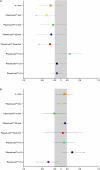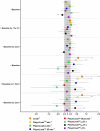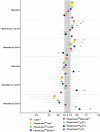A Standardized Small Sided Game Can Be Used to Monitor Neuromuscular Fatigue in Professional A-League Football Players
- PMID: 30131704
- PMCID: PMC6091256
- DOI: 10.3389/fphys.2018.01011
A Standardized Small Sided Game Can Be Used to Monitor Neuromuscular Fatigue in Professional A-League Football Players
Abstract
Introduction: Training and competition load can cause neuromuscular fatigue (NMF) and modified movement strategy such as an increase in the contribution of the medio-lateral [PlayerLoadTMML(%)] and decrease in the % vertical [PlayerLoadTMV(%)] vectors, to total PlayerLoadTM (accelerometer derived measurement in vertical, medio-lateral, and anterior-posterior planes) in matches. NMF assessment involves expensive equipment, however, given the modification of match movement strategy with NMF, this may be present in a standardized drill. The aim of this study was to determine the utility of a small sided game (SSG) for the measurement of NMF. Materials and Methods: Data was collected throughout a competitive football season. External load was quantified using global positioning system (GPS) and accelerometry, and internal load by session rating of perceived exertion (sRPE). A 5 vs. 5 SSG and countermovement jump (CMJ), for determination of flight time:contraction time (FT:CT), were performed the day prior to each match. Weekly volume from GPS, PlayerLoadTM and sRPE were calculated across the season. Weekly SSG activity profile and FT:CT was compared between "high" and "low" load weeks determined relative to season average. SSG activity profile was assessed between weeks where FT:CT was above or below pre-season baseline. Impact on match activity profile was examined between weeks where FT:CT and SSG activity profile were higher or lower than baseline. The difference (high vs. low load and < or > pre-season baseline) was calculated using the effect size (ES) ± 90% CI and practically important if there was a >75% likelihood of exceeding an ES of 0.2. Results: All weekly load metrics increased SSG PlayerLoadTM⋅m⋅min-1 when above season average, however, the impact on FT:CT was trivial. Reduced weekly FT:CT compared to baseline resulted in lower SSG PlayerLoadTM⋅min-1 and PlayerLoadTMSlow⋅min-1. FT:CT below baseline increased match PlayerLoadTMML(%) and decreased PlayerLoadTMV(%) during subsequent match play. Similarly, a reduction in SSG PlayerLoadTM⋅m⋅min-1 was followed by increased match PlayerLoadTMML(%). Conclusion: Changes in select match activity profile variables following a reduction in SSG PlayerLoadTM m.min-1, mirror those seen when FT:CT is reduced. Increased PlayerLoadTMML(%) during matches likely represents fatigue driven modification to movement strategy. Small-sided games may be a useful tool to detect NMF.
Keywords: GPS; PlayerLoadTM; accelerometer; countermovement jump; soccer; training load.
Figures





References
-
- Banister E. W., Calvert T. W., Savage M. V., Bach T. (1975). A systems model of training for athletic performance. Aust. J. Sports Med. 7 57–61.
LinkOut - more resources
Full Text Sources
Other Literature Sources
Miscellaneous

